Duration of Breeding Season in Beef Cattle Estrus Cycles
Body Condition Scoring of Cows
By David Lalman, Glenn Selk, Daniel Stein
- Jump To:
- Condition Scores
- Why Body Status is Important
- Conclusion
- References
Condition Scores
The torso condition scoring (BCS) organisation is used to appraise torso energy stores in beefiness cows. Energy stores are reflected primarily by the relative amount of fat available to metabolize as an energy source. When dietary energy is inadequate to meet the fauna's free energy need, fatty is mobilized along with some muscle and organ tissue. Said another style, when cows lose weight, they burn fat and some protein tissue (muscle and organ weight). When cows gain weight, they gain primarily fat tissue with minimal proceeds in protein tissue.
Body condition is important considering at that place is a shut relationship between BCS at calving and the beginning xc days after calving to reproductive success. In addition, cow body status influences the calf's power to develop a strong allowed system.
Current BCS is a snapshot in time of the balance between recent food supply and recent nutrient requirements. Many unlike direction factors influence this residual of supply vs demand. Overgrazing, for example, often leads to a situation where inadequate nutrient supply is available to meet the animate being'south requirements, eventually leading to weight loss. Body condition is a good reflection of the match or mismatch of a moo-cow's genetic potential to the fodder and direction arrangement.
The BCS organization used for beefiness cows range from one to ix, with a score of ane reflecting cows that are emaciated and a score of ix reflecting cows that are obese. Thin cows should receive a lower score and fat cows should receive a higher score. A description of each score follows and the advent of key areas of the body are provided in Effigy 1.
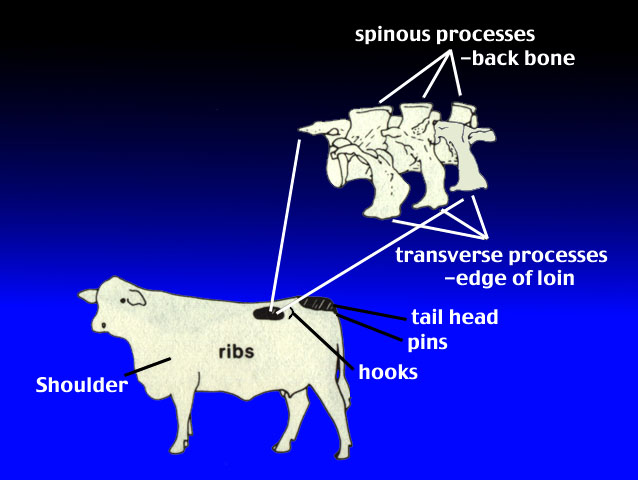 Effigy one. Key areas to examine for body condition scoring.
Effigy one. Key areas to examine for body condition scoring.
Cattle descriptions past the nine status scores follow:
BCS 1. The cow is severely emaciated and physically weak with all ribs and bone structure easily visible. Cattle in this score are extremely rare and are usually inflicted with a illness and/or parasitism.
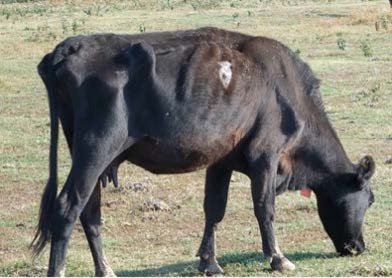
Figure 2. BCS 1.
BCS ii. (Figure 2) The cow appears emaciated, similar to BCS 1, only not weakened. Muscle tissue seems severely depleted through the hindquarters and shoulder.
BCS 3. (Figure 3) The cow is very sparse with no fat on ribs or in brisket and the backbone is easily visible. Some musculus depletion appears evident through the hindquarters.
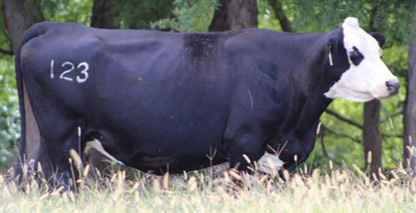
Effigy 3. BCS 3.
BCS four. (Figure 4) The moo-cow appears sparse, with ribs easily visible and the backbone showing. The spinous processes (forth the edge of the loin) are withal very sharp and barely visible individually. Muscle tissue is not depleted through the shoulders and hindquarters.
 Figure four. BCS 4.
Figure four. BCS 4.
BCS v. (Figure five) The cow may exist described every bit moderate to thin. The last ii ribs tin can exist seen and picayune evidence of fatty is nowadays in the brisket, over the ribs or effectually the tail head. The spinous processes are shine and difficult to identify.
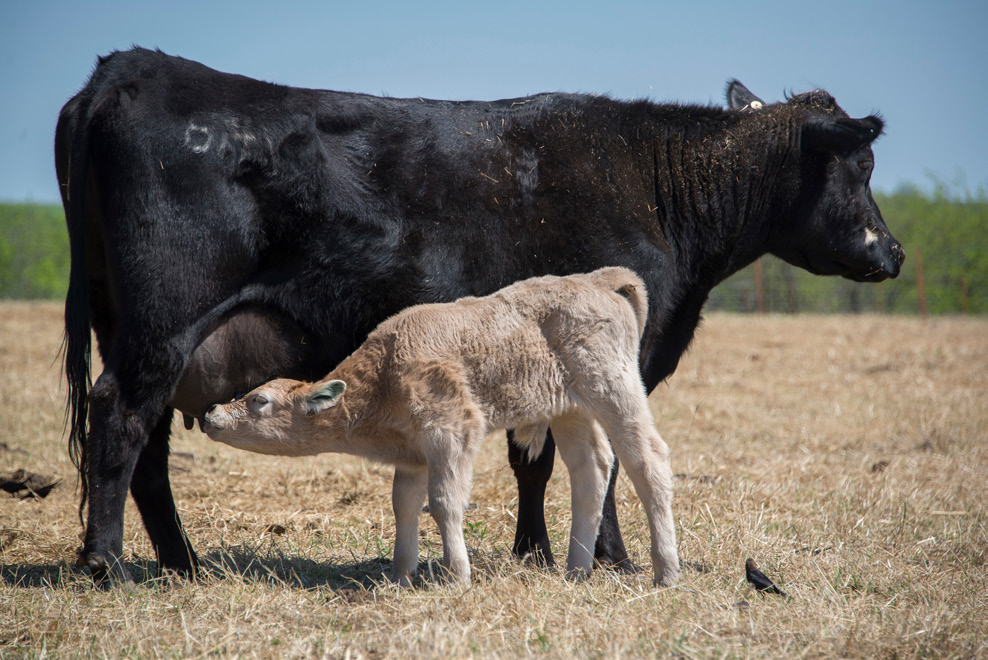 Figure 5. BCS 5.
Figure 5. BCS 5.
BCS 6. (Figure 6) The moo-cow exhibits a skillful polish appearance throughout. Some fat deposition is nowadays in the brisket and over the tail head. The back appears rounded and fatty can be palpated over the ribs and pin bones.
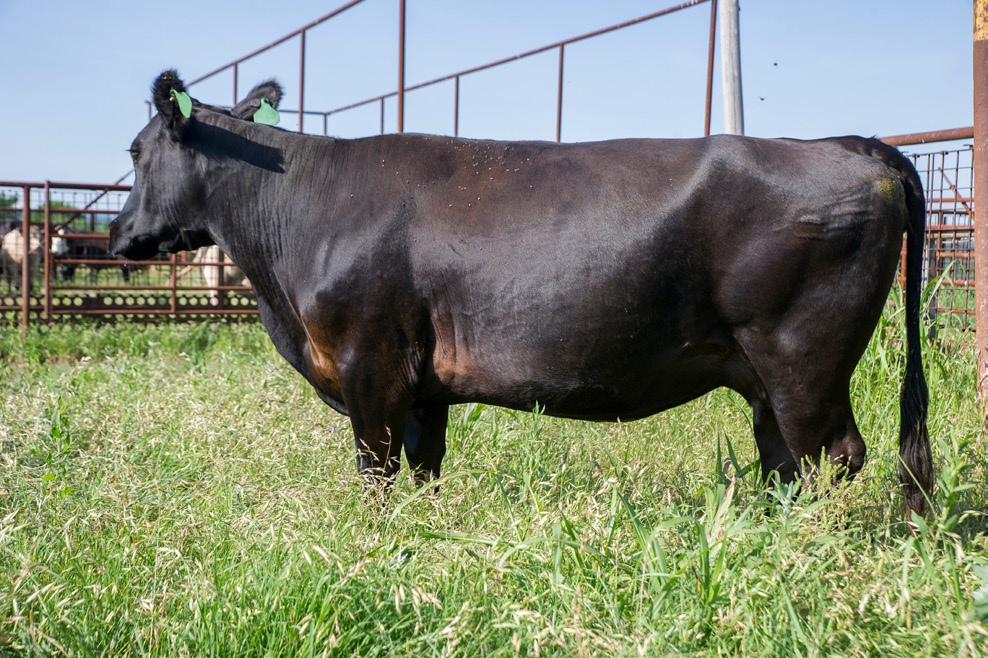 Figure 6. BCS half dozen.
Figure 6. BCS half dozen.
BCS 7. (Effigy 7) The cow appears in very proficient mankind. The brisket is total, the tail head shows pockets of fat and the back appears square due to fatty. The ribs are very smooth and soft handling due to fatty cover.
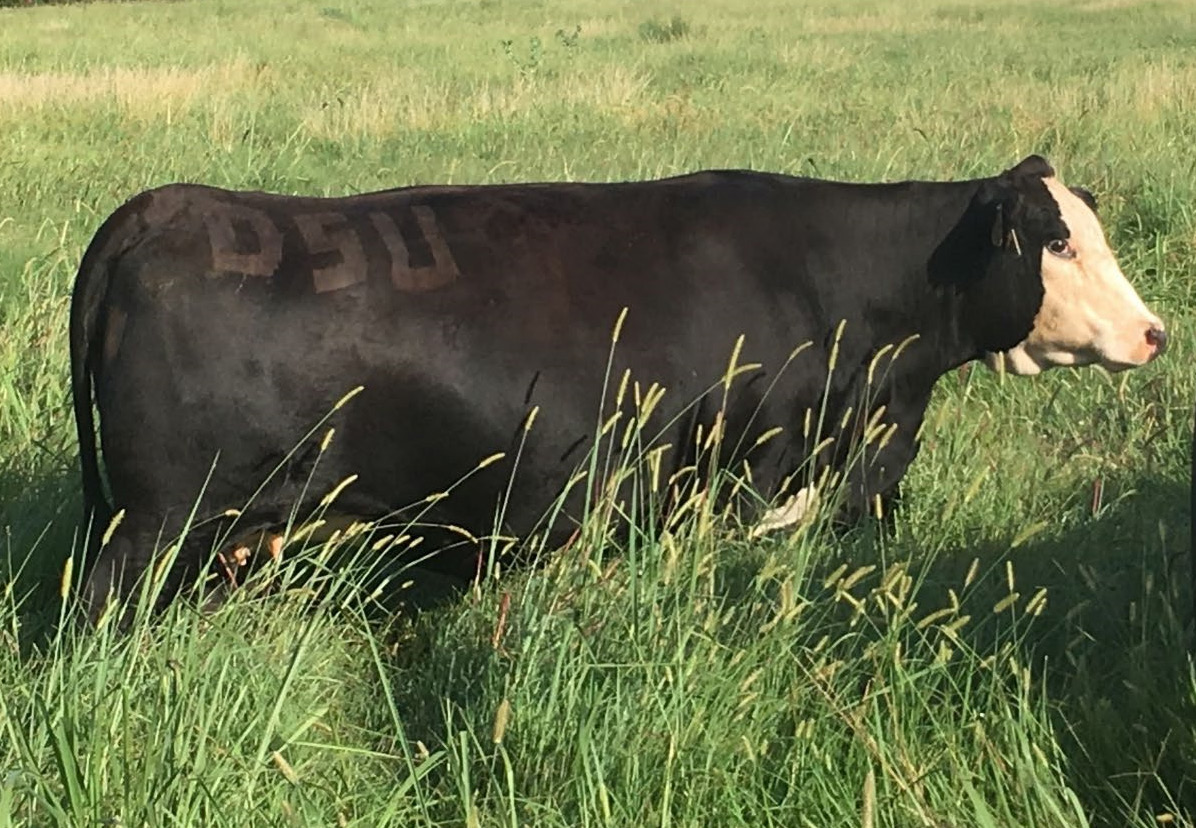 Figure 7. BCS – vii.
Figure 7. BCS – vii.
BCS 8. The cow is obese. Her neck is thick and short and her dorsum appears very square due to excessive fatty. The brisket is distended and she has heavy fat pockets around the tail head.
BCS 9. These cows are extremely obese and may have problems with mobility due to excessive weight and restriction of limbs. The brute'southward topline will be foursquare and flat with large dimples or pockets due to excessive fat embrace. The front leg prepare will be wide due to a bulging brisket. The entire underline will burl with fat, including the udder and naval. The tail head will not be visible as it will be covered in a big mass of fatty.
When status scoring cows, the technician should disregard (or look beyond) age, frame size, rib depth, trunk length, pregnancy status and hair coat. Status scoring is intended to provide a consistent organisation to quantify relative fatness regardless of these other factors that create differences in cows' advent.
There is a stiff relationship betwixt weight and body condition score. For each one-unit change in BCS, cows should gain or lose approximately 7% of their BCS-v weight (NASEM, 2016). For example, a cow that weighs 1,200 pounds when she is in BCS 5 should attain a BCS 6 at 1,284 pounds and a BCS four at one,116 pounds.
Why Trunk Status is Important
One of the major constraints in the improvement of reproductive efficiency of beef cows is the duration of the mail-calving anestrous period. If cows are to maintain a calving interval of one year, they must conceive within 80 days to 85 days after calving. Trunk status at calving time determines the rebreeding functioning of beef cows in the subsequent breeding season to a great extent (Selk).
 Figure viii. Per centum rebred at next breeding season per 24-hour interval, co-ordinate to body condition at calving (summary of six trials in 4 states) BCS 4 or less, BCS v, BCS 6 or more. Source: Field and Sands.
Figure viii. Per centum rebred at next breeding season per 24-hour interval, co-ordinate to body condition at calving (summary of six trials in 4 states) BCS 4 or less, BCS v, BCS 6 or more. Source: Field and Sands.
Figure eight represents the rebreeding percentage of six research herds in four states and includes mature as well as immature cows. Information technology clearly shows the body condition at calving greatly determines the rebreeding per centum of cows during the subsequent 60- to 90-day convenance season. Based on research with mature and immature cows, those maintaining body weight, therefore, having aplenty energy reserves earlier parturition, exhibited estrus sooner than cows that lost considerable body weight and consequently had poor energy reserves. Body weight alter during pregnancy is confounded with embryo and placenta growth. Therefore, the estimation of trunk fat by use of trunk status scores is more useful in quantifying the energy status of beefiness cows. The numeric organisation of trunk condition scoring is an splendid estimator of percent torso fat in beef cows. Body condition score accounted for 85% to 91% of the variation in stored body energy (percent fat) in cows.
The processes of fetal development, delivering a calf, milk production and repair of the reproductive tract all are physiological stresses. These stresses require the availability and utilization of big quantities of energy to enable cows to exist rebred in the required 85 days. Add together to these physiological stresses the environmental stress of cold, wet weather condition on bound calving cows and the nutritional stress of energy intake that is below body maintenance needs. Every bit the intake falls curt of the energy utilized, the cow compensates by mobilizing stored energy or adipose tissue, and through a period of several weeks, a noticeable change in the outward appearance of the cow takes place.
This is a modify in the body condition and can exist monitored by assigning body condition scores to cows and quantifying the degree of change. Cows in a thin trunk status at calving return to estrus slowly. Postpartum increases in energy intake tin can change the length of the postpartum interval. Still, increases in the quality and quantity of feed to increase postpartum body condition can exist very expensive.
Improvement in reproductive performance accomplished by expensive postpartum feeding to thin cows may not be adequate to justify the price of the additional nutrients. Oklahoma scientists used 81 Hereford and Angus x Hereford heifers to written report the effects of body condition score at calving and postpartum nutrition on rebreeding rates at 90 days and 120 days postpartum (Bong et al.). Heifers were divided into two groups in November and allowed to lose body condition or maintain trunk condition until calving in Feb and March. Each of those groups was and then divided and fed to gain weight and body condition postpartum or to maintain body condition postpartum.
Figure 9 illustrates the modify in body weight of heifers that calved with a greater than BCS v, or those that calved with a BCS less than or equal to 4.9. The same pattern has been illustrated in the other experiments is manifest clearly with these heifers. Thin heifers that were given aplenty opportunity to regain weight and body condition after calving actually weighed more and had greater body condition by eight weeks than those heifers that had practiced body condition at calving and maintained their weight through the breeding flavour. However, the rebreeding performance (on the correct side of the fable of the graph) was significantly lower for those that were thin (67%) at parturition compared to heifers that were in adequate body condition at calving and maintained condition through the breeding season (91%). Postpartum increases in free energy therefore, weight and body condition gave a minor improvement in rebreeding performance, but the increased expense was non adequately rewarded. The groups that were fed to maintain postpartum condition and weight received 4 pounds of cottonseed meal supplement (41% rough protein; $.13 per pound) per day.
 Figure 9. Postpartum torso weight of heifers with trunk condition < 5 or ≥ five at calving and fed to gain or maintain weight. Pregnancy rates are indicated on the right side of the legend. Source: Bong.
Figure 9. Postpartum torso weight of heifers with trunk condition < 5 or ≥ five at calving and fed to gain or maintain weight. Pregnancy rates are indicated on the right side of the legend. Source: Bong.
The supplement toll for the 69-day feeding catamenia was approximately $36 per cow. The cows in the gain groups were fed 28 pounds of a grain mix (12% CP; $.073 per pound) at a total supplement cost of $141. Both groups had free choice access to grass hay (Wettemann). The improvement in reproductive operation (67% pregnant versus 36% significant) of the thin ii-year-old heifers was not enough to offset the big investment in feed costs in most cases.
Other information sets have shown conclusively cows that calve in thin body condition, simply regain weight and condition going into the breeding season, do not rebreed at the same rate equally those that calve in expert status and maintain that condition into the breeding season. Table 1 from Missouri researchers illustrates the number of days between calving to the return to rut cycles depending on body condition at calving and trunk condition change subsequently calving.
This information clearly shows young cows that calve in thin torso condition (BCS 3 or BCS 4) cannot gain enough torso condition after calving to achieve the same rebreeding performance as cows that calve in moderate torso condition (BCS five.v) and maintain or lose only a slight amount of condition.
Cows must be rebred by 85 days after calving to calve once more at the aforementioned time the next yr. Find that none of the averages for cows that calved in thin body condition were recycling in fourth dimension to maintain a 12-month calving interval.
Tabular array 1. Predicted number of days from calving to outset oestrus as affected by torso condition score at calving and body condition score modify later on calving in immature beef cows. (body condition score scale : 1 = emaciated; 9 = obese).
| Condition score modify after calving to day ninety | |||||||
|---|---|---|---|---|---|---|---|
| BCS at calving | -one | -0.v | 0 | 0.v | 1 | i.5 | 2 |
| iii | 189 | 173 | 160 | 150 | 143 | 139 | 139 |
| 4 | 161 | 145 | 131 | 121 | 115 | 111 | 111 |
| 5 | 133 | 116 | 103 | 93 | 86 | 83 | 82 |
| v.five | 118 | 102 | 89 | 79 | 72 | 69 | 66 |
Source: Lalman et al.
Decision
Producers should manage their calving season, genetics, grazing system, supplementation programme and herd health to achieve herd average BCS of 5 to 6 in mature cows at calving fourth dimension and BCS 6 in outset-dogie heifers at calving time. Later, producers should manage their functioning with the goal of minimizing the amount of weight and BCS loss betwixt the time of calving and breeding. Early management to meet these goals are important considering desperate changes in BCS during late-pregnancy and early lactation are extremely difficult and costly to accomplish.
References
Bell, D. et al. (1990) Furnishings of Torso Condition Score at Calving and Postpartum Diet on Performance of Two-Year-Old Heifers. OSU Animal Scientific discipline Inquiry Report MP-129.
M.J. Field and R.S. Sand, Eds. Factors Affecting Calf Ingather (1994). CRC Press, Inc., Boca Raton, FL.
Lalman, D.L. et al. (1997) Influence of Weight and Body Condition Alter on Duration of Anestrus by Undernourished Suckled Beefiness Heifers. Journal of Animal Science 75.
Selk, G.E. et al. (1988) Relationships among Weight Alter, Body Status and Reproductive Operation of Range Beefiness Cows. Journal of Animal Science 66:3153.
Vizcarra, J.A. et al. (1995) Body Status Score is a Precise Tool to Evaluate Beef Cows. OSU Animate being Science Enquiry Written report P-943.
Wettemann, R.P. (2004) Personal Advice.
Was this data helpful?
YESNO
melendezasher1949.blogspot.com
Source: https://extension.okstate.edu/fact-sheets/body-condition-scoring-of-cows.html
0 Response to "Duration of Breeding Season in Beef Cattle Estrus Cycles"
Post a Comment